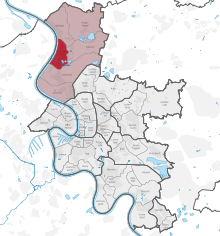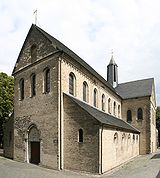- Düsseldorf-Kaiserswerth
-
 Kaiserswerth in 1646, engraving by Matthäus Merian
Kaiserswerth in 1646, engraving by Matthäus Merian
 map of Düsseldorf, showing Kaiserswerth (in red) within District 5 (in pink)
map of Düsseldorf, showing Kaiserswerth (in red) within District 5 (in pink)
Kaiserswerth is one of the oldest parts of the City of Düsseldorf. It is in the north of the city and next to the river Rhine. It houses the Deaconess's Institute of Kaiserswerth where Florence Nightingale studied.
Kaiserswerth has 7,712 inhabitants and an area of 4.71 km².
Contents
History
About the year 700 the monk Saint Suitbert founded a Benedictine abbey at Werth an island that formed an important crossing point of the Rhine. The abbey was destroyed 88 years later. On that area there is now the "Erzbischöfliches Suitbertus-Gymnasium", an archiepiscopal secondary school with the old chapel and parts of the abbey. The former monastery garden is a meeting point for the upper school between lesson times.
The Kaiserpfalz (temporary seat of the Holy Roman Emperor) was built in 1045. In 1062, the archbishop of Cologne, Anno II, kidnapped the underage German King Heinrich IV from here and in this way obtained the unofficial regency of the Holy Roman Empire. At this time the island's name changed from Werth to Kaiserswerth. In 1174, Friederick I Barbarossa moved the Rhine customs collection to Kaiserswerth. The eastern branch of the Rhine around the island silted up connecting Kaiserswerth to the east bank of the river. In 1273, the emperor pledged Kaiserswerth to the Archbishop of Cologne forming a de facto enclave within the Duchy of Jülich-Berg. In 1591, Friedrich Spee von Langenfeld was born in Kaiserswerth.
Due to its strategic position the town changed regularly. The town was captured in 1586 during the Cologne War, and then occupied by the Spanish from 1589 to 1592. In 1636 the town was captured again by the forces of Hesse. When in 1688 the Elector of Cologne made an alliance with Louis XIV during the War of the Grand Alliance he gave the French access to the Rhine crossing at Kaiserswerth. This caused the Dutch and Brandenburg to lay siege to the town in the June of 1689. The French garrison surrendered at the end of the month when their supplies were destroyed by fire. The French reoccupied Kaiserswerth in 1701 during the War of the Spanish Succession and the Allies laid siege to it again in 1702. After a long and hard struggle the town surrendered and the Alliance decided to demolish the fortifications[1].
In the 19th century Kaiserswerth was famous for its deaconess clinic, where Florence Nightingale was educated.
In both World Wars there was a great military hospital in Kaiserswerth.
Kaiserswerth became a part of Düsseldorf in 1929.
Infrastructure
Kaiserswerth is connected to the central stations and the central districts of the cities of Düsseldorf and Duisburg by the metropolitan railway line U 79. There are some bus lines to other parts of Düsseldorf, to Mettmann, Krefeld, Ratingen and Düsseldorf International Airport. There is a ferry crossing the Rhine over to Meerbusch
Bibliography
- Christa-Maria Zimmermann / Hans Stöcker (Hrsg.), Edmund Spohr: Kayserswerth, 1300 Jahre, Heilige, Kaiser, Reformer. Herausgegeben im Auftrag der Landeshauptstadt Düsseldorf, Kulturamt. 2. durchgesehene Auflage. Triltsch Verlag, Düsseldorf 1981, ISBN 3-7998-0005-0
References
External links
- Wir Kaiserswerther e.V.
- Kaiserswerther Diakonie
- Siege of Kaiserswerth in 1702
- Websites from Düsseldorf-Kaiserswerth on Duesselgo.de
Districts of Düsseldorf District 1 · District 2 · District 3 · District 4 · District 5 · District 6 · District 7 · District 8 · District 9 · District 10 District 1: Altstadt · Derendorf · Golzheim · Carlstadt · Pempelfort · Stadtmitte | District 2: Düsseltal · Flingern-Nord · Flingern-Süd | District 3: Bilk · Flehe · Friedrichstadt · Hafen · Hamm · Oberbilk · Unterbilk · Volmerswerth | District 4: Heerdt · Lörick · Niederkassel · Oberkassel | District 5: Angermund · Kaiserswerth · Kalkum · Lohausen · Stockum · Wittlaer | District 6: Lichtenbroich · Mörsenbroich · Rath · Unterrath | District 7: Gerresheim · Grafenberg · Hubbelrath · Ludenberg | District 8: Eller · Lierenfeld · Unterbach · Vennhausen | District 9: Benrath · Hassels · Himmelgeist · Holthausen · Itter · Reisholz · Urdenbach · Wersten | District 10: Garath · HellerhofCategories:
District 1: Altstadt · Derendorf · Golzheim · Carlstadt · Pempelfort · Stadtmitte | District 2: Düsseltal · Flingern-Nord · Flingern-Süd | District 3: Bilk · Flehe · Friedrichstadt · Hafen · Hamm · Oberbilk · Unterbilk · Volmerswerth | District 4: Heerdt · Lörick · Niederkassel · Oberkassel | District 5: Angermund · Kaiserswerth · Kalkum · Lohausen · Stockum · Wittlaer | District 6: Lichtenbroich · Mörsenbroich · Rath · Unterrath | District 7: Gerresheim · Grafenberg · Hubbelrath · Ludenberg | District 8: Eller · Lierenfeld · Unterbach · Vennhausen | District 9: Benrath · Hassels · Himmelgeist · Holthausen · Itter · Reisholz · Urdenbach · Wersten | District 10: Garath · HellerhofCategories:- Urban districts and boroughs of Düsseldorf
- Düsseldorf
- Visitor attractions in Düsseldorf
- History of Düsseldorf
Wikimedia Foundation. 2010.



